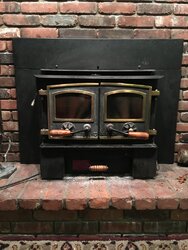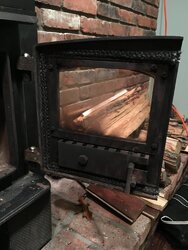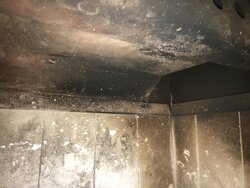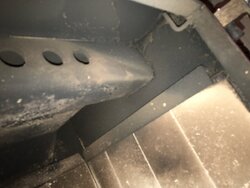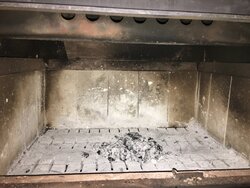Hi Everyone,
I recently moved into a house with an existing Brunco Hearthglow insert, pictured below.
It's technically a coal burner, so the "primary" air is fed through an opening between the ash pan and the bottom of the doors and comes up through the bottom grates inside the firebox. It can be controlled via a lever on the left-hand side of the stove, which is attached to a bi-metal spring for pseudo-responsive temperature control. The doors also have spinners with inner baffles to direct the "secondary" air up across the windows.
I've been reading tons of great articles about retrofitting older "smoke dragons" with baffles and secondary burn tubes to clean up the combustion. It's amazing what a drastic difference this seemingly simple modification can make! While this stove does have a baffle, I'm hoping to add secondary burn tubes + heated air inlet, as well as perhaps replace the existing baffle with one that extends further to the sides in order to provide more opportunity for the gasses to burn.
I was hoping I could run some of my ideas by you guys to get your thoughts before I drill any holes in this thing haha. Here's my plan:
1. Drill a 3/4" hole in the top of the stove (haven't decided left/right/center) to pull air for the secondary burners. The reason I want to pull air from the top (vs. most people seem to prefer sides/back) is that the blowers drive air around the stove from the bottom, up the back, and across the top, which results in very hot air at that location. If I can pull this air into the firebox for the secondary burn, I won't have to worry as much about providing a super long run for it to super heat inside the box.
2. Replace the current baffle with a steel plate that covers the entire top of the firebox. The current baffle leaves ~4inches of open space on either side, allowing smoke and gasses to escape out the top pretty quickly. By extending the plate to either side, I'll force more of the gasses to take the long road by either going all the way to the edge of the plate, or swinging around the front of the stove and going through those holes in the front baffle shelf thing. (By the way, what is that for???)
3. Create secondary burn assembly using black iron pipe w/ connectors the way many others on this forum have. Feed air into the frame from the hole from step 1. Rest the frame exactly where the current baffle plate is, and put the new baffle on top of that frame.
I'm hoping that with these modifications I can rely mostly on the front spinners for primary air supply and not use the bottom-fed supply most of the time.
Let me know what you think, if you have better ideas, or if anything is unclear.
Thanks!
I recently moved into a house with an existing Brunco Hearthglow insert, pictured below.
It's technically a coal burner, so the "primary" air is fed through an opening between the ash pan and the bottom of the doors and comes up through the bottom grates inside the firebox. It can be controlled via a lever on the left-hand side of the stove, which is attached to a bi-metal spring for pseudo-responsive temperature control. The doors also have spinners with inner baffles to direct the "secondary" air up across the windows.
I've been reading tons of great articles about retrofitting older "smoke dragons" with baffles and secondary burn tubes to clean up the combustion. It's amazing what a drastic difference this seemingly simple modification can make! While this stove does have a baffle, I'm hoping to add secondary burn tubes + heated air inlet, as well as perhaps replace the existing baffle with one that extends further to the sides in order to provide more opportunity for the gasses to burn.
I was hoping I could run some of my ideas by you guys to get your thoughts before I drill any holes in this thing haha. Here's my plan:
1. Drill a 3/4" hole in the top of the stove (haven't decided left/right/center) to pull air for the secondary burners. The reason I want to pull air from the top (vs. most people seem to prefer sides/back) is that the blowers drive air around the stove from the bottom, up the back, and across the top, which results in very hot air at that location. If I can pull this air into the firebox for the secondary burn, I won't have to worry as much about providing a super long run for it to super heat inside the box.
2. Replace the current baffle with a steel plate that covers the entire top of the firebox. The current baffle leaves ~4inches of open space on either side, allowing smoke and gasses to escape out the top pretty quickly. By extending the plate to either side, I'll force more of the gasses to take the long road by either going all the way to the edge of the plate, or swinging around the front of the stove and going through those holes in the front baffle shelf thing. (By the way, what is that for???)
3. Create secondary burn assembly using black iron pipe w/ connectors the way many others on this forum have. Feed air into the frame from the hole from step 1. Rest the frame exactly where the current baffle plate is, and put the new baffle on top of that frame.
I'm hoping that with these modifications I can rely mostly on the front spinners for primary air supply and not use the bottom-fed supply most of the time.
Let me know what you think, if you have better ideas, or if anything is unclear.
Thanks!


